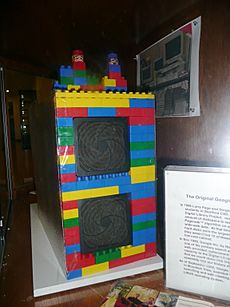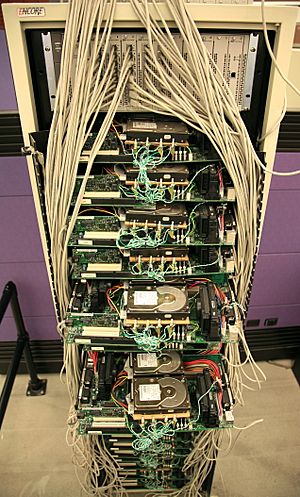History of Google facts for kids
Google is a huge technology company that started in 1998. It was created by Larry Page and Sergey Brin while they were students at Stanford University in California. They first developed a search program called "BackRub" in 1996. This search program quickly became very popular.
Google grew fast and moved its main office to Mountain View in 2003. In 2004, Google offered its shares to the public for the first time, becoming one of the world's biggest media companies. Over the years, Google launched many popular products like Google News (2002), Gmail (2004), Google Maps (2005), and Google Chrome (2008). In 2015, Google became the main part of a larger company called Alphabet Inc..
Google also works with other companies like NASA and AOL. It even has a charity called Google.org, which started in 2005. The name "Google" comes from a math term, "Googol", which is the number 1 followed by 100 zeros. This name was chosen to show that Google wanted to organize a huge amount of information.
Contents
Google's Story
How It Started
Google began as a research project called "BackRub" in 1996. Larry Page and Sergey Brin were PhD students at Stanford University in California. They were joined by Scott Hassan, who helped write much of the early code.
Larry Page was interested in how web pages link to each other. He thought that the number and type of links pointing to a page could show how important that page was. This idea was similar to how citations work in school papers. Scott Hassan started writing the computer code for Page's ideas.
Sergey Brin joined the project soon after. He and Page had met in 1995. They were both working on a project to create a huge digital library.
In March 1996, Page's computer program started exploring the internet. To figure out which web pages were most important, Brin and Page created the PageRank algorithm. They realized that a search engine using PageRank would give much better results than other search engines at the time. Those older search engines just looked at how many times a search word appeared on a page.
Page and Brin believed that pages with many links from other important pages were the most relevant. They tested this idea as part of their studies. The first version of Google was released in August 1996 on Stanford's website. It used a lot of the university's internet connection!
Larry Page thanked Scott Hassan and Alan Steremberg for their help. Other people like Rajeev Motwani and Terry Winograd also helped write the first paper about Google.
Growing Bigger in the 1990s
At first, Google used Stanford's website addresses like google.stanford.edu. The name google.com was registered on September 15, 1997. The company, Google, was officially started on September 4, 1998. It began in their friend Susan Wojcicki's garage in Menlo Park, California. Susan Wojcicki later became a top executive at Google and then the CEO of YouTube.
Larry Page and Sergey Brin originally didn't want ads on their search engine. But they soon changed their minds and allowed simple text ads.
By the end of 1998, Google had indexed about 60 million web pages. Even though its homepage still said "BETA" (meaning it was still being tested), people already thought Google's search results were better than other popular websites like Hotbot or Excite.com.
In early 1999, Brin and Page thought about selling Google to a company called Excite for $1 million. But Excite's CEO said no.
In March 1999, Google moved to offices in Palo Alto. After quickly outgrowing two more places, the company rented a group of buildings in Mountain View in 2003. This place is now known as the Googleplex. In 2006, Google bought the property.
The 2000s: A New Era
Many internet users loved Google's simple design. In 2000, Google started selling ads that appeared next to search results. These ads were just text to keep the page clean and load quickly. Companies paid based on how many times people clicked their ads. This way of selling ads helped Google make money while many other internet companies were struggling.
Google's motto was "Don't be evil". They even put this phrase in their official document when they first sold shares to the public in 2004. They believed that doing good things for the world would help them in the long run.
In 2003, Google bought Pyra Labs, which owned the blogging website Blogger. This helped Google use information from blogs to make its search results and Google News better.
In 2004, another big company, Yahoo!, stopped using Google's search technology. This showed how unique Google had become. The word "to google" even became a common verb, meaning "to search for information on the internet."
After Google sold its shares to the public, its value grew a lot. By June 2005, Google was worth almost $52 billion, making it one of the biggest media companies in the world.
Google started to face more competition from other big tech companies like Microsoft. Microsoft promoted its own search engine, Bing. Both companies also offered similar services like email (Gmail vs. Hotmail) and online maps. Google even made its own computer operating system, Linux-based Chrome OS, to compete with Microsoft Windows. In 2008, Google released its own web browser, Google Chrome.
Google also tried new markets like radio and print ads. In 2006, Google bought a radio advertising company. It also experimented with selling ads in newspapers like the Chicago Sun-Times.
In 2008, Google launched Knol, which was like Wikipedia, but it didn't last long and closed four years later.
How Google Uses Cookies
Google makes most of its money from advertising. In 2007, Google bought a company called DoubleClick. This helped Google start using "cookies" to track what people do online. Cookies are small files that websites put on your computer to remember things about you. This tracking helps Google show you more relevant ads.
In 2016, Google changed how it used this information. It started combining the data from ads with information from its other services. This meant Google could create a more complete picture of what you do online.
The 2010s and Beyond
In 2011, Google launched Google+, which was its fourth attempt at a social network. It followed Google Buzz, Google Friend Connect, and Orkut. Google+ was later shut down in 2019.
By November 2014, Google had over 70 offices in more than 41 countries around the world.
In 2015, Google changed its structure and became the main part of a new parent company called Alphabet Inc.. Google continued to handle all of Alphabet's internet businesses.
In March 2019, Google announced it would enter the video game market with a cloud gaming platform called Google Stadia.
In June 2019, the United States Department of Justice started looking into Google for possible antitrust violations. This means they were checking if Google was too powerful in the search and search advertising markets. A lawsuit was filed in October 2020.
In April 2020, during the COVID-19 pandemic, Google announced it would slow down hiring and reduce spending in some areas.
In 2020, Google services had some outages, meaning they stopped working for a few hours. This affected services like Google Drive and YouTube.
In January 2021, the Australian Government suggested a law that would make Google pay news companies for using their content. Google responded by saying it might stop its search engine in Australia.
Getting Money and Going Public
Google's first money as a company came in August 1998. Andy Bechtolsheim, a co-founder of Sun Microsystems, gave them $100,000 even before the company officially existed!
In June 1999, Google got another $25 million from big investment firms. Larry Page and Sergey Brin didn't want to sell shares to the public yet because they wanted to keep control of Google.
But they eventually agreed to hire a CEO. In March 2001, Eric Schmidt became Google's first CEO.
In 2003, Microsoft talked to Google about working together or merging, but nothing happened. In January 2004, Google announced it would sell shares to the public for the first time. This is called an initial public offering (IPO). They hoped to raise $4 billion.
Google's IPO happened on August 19, 2004. They offered over 19 million shares at $85 each. This raised $1.67 billion and made Google worth over $23 billion. Many Google employees became millionaires overnight. Even Yahoo!, a competitor, benefited because it owned some Google shares.
After the IPO, Larry Page, Sergey Brin, and CEO Eric Schmidt asked for their salaries to be cut to just $1 per year. They turned down offers for higher salaries because they made most of their money from owning Google stock.
Some people worried that selling shares to the public would change Google's company culture. But the founders promised that the IPO would not change how Google worked.
Google's shares were listed on the NASDAQ stock exchange under the symbol GOOG. When Alphabet Inc. was created, it kept Google's stock history and symbol.
What's in a Name?
The name "Google" came from a mistake in spelling "googol". A googol is the number 1 followed by 100 zeros (10100). Page and Brin chose this name because it showed their goal of building a huge search engine that could handle a massive amount of information.
The name "Google" has been used in other ways before. For example, there was a comic strip character named Barney Google in 1919. The British children's author Enid Blyton also used "Google Bun" in her books.
The verb "google" was added to dictionaries like the Merriam Webster Collegiate Dictionary and the Oxford English Dictionary in 2006. It means "to use the Google search engine to find information on the Internet." The first time "Google" was used as a verb in popular culture was on the TV show Buffy the Vampire Slayer in 2002.
Working with Others: Partnerships
Google has teamed up with many companies and organizations to improve its products and services.
On September 28, 2005, Google announced a long-term research partnership with NASA. They planned to build a huge research center at NASA's Ames Research Center. NASA and Google wanted to work together on things like managing large amounts of data and new technologies.
In October 2006, Google partnered with Sun Microsystems to share their technologies. Google even hired people to help with the OpenOffice.org program, which is a free office software.
On December 21, 2005, Google and AOL announced a bigger partnership. Google invested $1 billion in AOL and planned to work with them on video search.
In August 2006, Google signed a $900 million deal with News Corp. to provide search and advertising for websites like Myspace and IGN.
On December 6, 2006, British Sky Broadcasting and Google announced an alliance. This included Gmail linking with Sky to offer email services with an "@sky.com" address.
In 2007, Google became a key partner for the NORAD Tracks Santa program. Google Earth was used for the first time to let people follow Santa Claus in 3D. The program also appeared on YouTube thanks to Google's partnership.
In 2008, Google worked with GeoEye to launch a satellite. This satellite provides Google with very detailed images for Google Earth. Google also announced that it was hosting an archive of Life Magazine photographs.
In January 2009, Google partnered with the Pontifical Council for Social Communications. This allowed the Pope to have his own channel on YouTube.
In January 2013, Google announced a partnership with Kia Motors and Hyundai. This partnership brought Google Maps into new car models.
Google is also part of the Alliance for Affordable Internet (A4AI), which started in October 2013. This group, led by Sir Tim Berners-Lee (who invented the World Wide Web), aims to make internet access cheaper and more available in developing countries.





